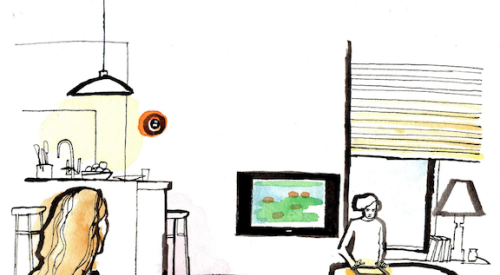| A basic network distribution panel (above) includes a voice and data switcher panel with room for several lines; a video switcher that distributes one or two video feeds to a handful of locations in a home; an empty 2-inch conduit run from the panel location to the attic or crawl space; and perhaps a 110-volt power source that facilitates upgrades to more sophisticated devices. |
Try this experiment: Visit a home you built 10 or as recently as five years ago. More than likely it was built without a basic structured wiring system. Have the owner show you where the computer, printer and fax machine are set up. Then look behind those devices and follow the power cords and communication cables to each of the devices and into the wall outlets. There you will find a tangled mass of wires connected to other wires that run along the baseboard to other locations around the room.
Look closer, and that tangled mess be-comes even more complex. In homes with only one telephone line you’ll see a hardware-store-bought splitter pushed into the wall jack. From there, separate lines often run to the phone, the computer and the fax machine.
Then think about the day, now or in the near future, when the telephone or cable guy comes to run a second line into the house for DSL or high-speed cable Internet access. The homeowner would pay dearly to have either service linked to more than one room but likely will spare the expense and do without the extra locations. That means every time Junior surfs the Web, he’ll either tie up a voice line or occupy the only location in the house with a fast data connection, a voice line and a printer.
The point is that for $500 to $900 builders can install a basic to intermediate structured wiring system that will make their buyers’ computing and communication lives a lot simpler and more flexible.
When your architect or designer “makes room” in your floor plans for computers in the kitchen, home office or study hall/technology loft, make it a point to call your security or audio-video subcontractor to price a basic structured wiring package for each plan. For buyers, the benefits are significant.
Depending on the type of structured wiring system, all computers in the home, both portable and desktop, then can access the same high-speed DSL or cable modem connection. Someone sending e-mail from the kitchen could print out a hard copy in the home office, eliminating the need for a separate printer in each location. And that tangled mess will become a lot less formidable while the entire system becomes much easier to change and update, almost plug-and-play.
| In addition to a larger voice/data switcher, a better (and more costly) panel includes a multiport, bidirectional video amplifier that leaves more room for cable television, satellite TV and security video feeds; a 110-volt power source; and in exceptional cases fiber-optic cable in lieu of the empty 2-inch conduit. |
Oh, and when the cable or phone guy comes to add service or swap out analog equipment for digital, he’ll need to bring it to only one central switching location that goes by one of multiple names: the network hub, control panel or headend.
To determine the equipment required for a basic or slightly better-than-basic structured wiring system, we sought help from two kinds of experts: low-voltage systems integrators and builders who, after years of research, are offering a basic package for all their home buyers. Most low-voltage systems integrators have stayed in business by installing robust systems in luxury homes, whether for remodels, retrofits, new custom homes or spec homes. That’s why many have a difficult time understanding just how basic the technology needs are for most buyers of production homes.
Richard Holtz is president of InfiniSys Inc., a Daytona Beach, Fla.-based systems integrator that has installed basic home networking systems for builders of low-rise rental and condominium units in 30 states. He has a lot of production housing experience. That said, his “basic” panel includes energy management and lighting control, above and beyond structured wiring, which typically pertains only to phone, data and video distribution to various locations in the house. Holtz recommends a panel that includes the following:
After considerable market and technology research, J.F. Shea Co., parent of Giant Shea Homes, has settled on a package far more basic than Holtz’s. Rob Pigg, vice president of operations for J.F. Shea, says most of the company’s divisions have adopted the companywide specifications, which originally grew out of its Phoenix-based active-adult division. The detailed Shea specifications are proprietary but generally consist of a small telephone and data network device and a small video-switching device in a panel mounted in a bedroom closet. Phone and video services are installed in the garage and run from there to a panel location.
Nearly in line with Holtz’s relatively robust recommendation is Indianapolis-based builder/developer Estridge Communities, says Mark Flagg, its vice president of product development. Estridge’s basic package, depending on the price of the home, can include fiber-optic cable as standard. Most homes, however, get a relatively large voice and data switcher capable of sending signals to most rooms of a home; a video amplifier; and an eight-port 10BaseT Ethernet computing hub.
The central point of agreement among all three is the type of wire to run. For telephony, it is Cat5E, short for Category 5 Enhanced. For video cable, the nearly universal choice is RG-6 shielded coaxial. Another point of agreement: All wire should be home-run to the network hub, not daisy-chained from location to location.
Once the wires have been run, there are many options for terminating those connections in a kitchen organizing center, a home office, a study hall or a technology loft.










